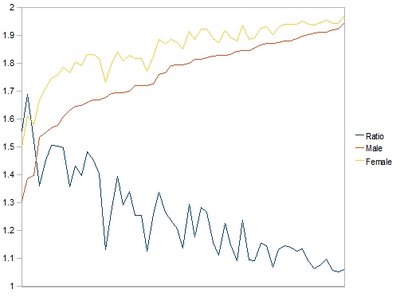|
Sunday, August 24, 2008
 A few years ago Bryan Caplan argued that the cross-cultural male-female sex difference was due some innate differences. And specifically the differences he postulated explained why the less religious a society was the greater the sex difference. I took data from Rodney Stark's original paper (N = 54 nations), log-transformed the proportions of males and females who claimed to be religious, and plotted them along with the sex ratio (sorted by increasing male religiosity from left to right). As you can plainly see, the trends converge as the societies become progressively more religious and the sex ratio attenuates. Full disclosure, I discarded China from the list of nations because it was such an outlier of irreligiosity compared to every other nation and I didn't want to change the scaling too much. Stark has a follow up paper which explores this pattern of greater sex differences in religiosity with decreased traditionalism in the social milieu. A few years ago Bryan Caplan argued that the cross-cultural male-female sex difference was due some innate differences. And specifically the differences he postulated explained why the less religious a society was the greater the sex difference. I took data from Rodney Stark's original paper (N = 54 nations), log-transformed the proportions of males and females who claimed to be religious, and plotted them along with the sex ratio (sorted by increasing male religiosity from left to right). As you can plainly see, the trends converge as the societies become progressively more religious and the sex ratio attenuates. Full disclosure, I discarded China from the list of nations because it was such an outlier of irreligiosity compared to every other nation and I didn't want to change the scaling too much. Stark has a follow up paper which explores this pattern of greater sex differences in religiosity with decreased traditionalism in the social milieu.As Bryan notes Stark has his own particular model for why this sex difference persists. I have some issues in the details with Bryan's hypotheses, but I think he's going in the right direction. That being said, I wonder if some of the differences across societies might be viewed through individual vs. group dynamics. In societies where religions are personal choices, and "switching" or "defecting" does not entail high costs, then it is rational to "shop around" for the best bundle of characteristics which are congenial to your own preferences (or, one can opt-out of the whole institution). Some sort of neoclassical inspired rational choice model might work very well in these societies; the United States is probably one such culture (about 16% of Americans "switch" in their lifetime according to the Religious Identification Survey). But a society like Saudi Arabia or even Italy is far less of a rational individualist utopia; traditional religions operate like monopolies and there are powerful group level pressures to conform at the expense of personal actualization. Men and women have the same cognitive biases, but they're channeled and express in very different ways. Finally, I was curious as to insights from the Pew Religious Landscape Survey. Trends were hard to spot; whatever group level effects I'm alluding to might be extant only on the scale of national cultures. But, I did notice that when there were two Protestant denominations which split on liberal-conservative lines, such as the American and Southern Baptists, or the Presbyterian Church in America and Presbyterian Church USA, the conservative denomination had proportionately more males. One hypothesis might be that the constraints, or disincentives via social sanction and ostracism, are low enough in the more liberal sects that they suffer high male defection rates vis-a-vis their conservative counterparts. Unfortunately the N for the GSS to answer these questions just isn't there, so I'll have to dig elsewhere.... Labels: Religion |



